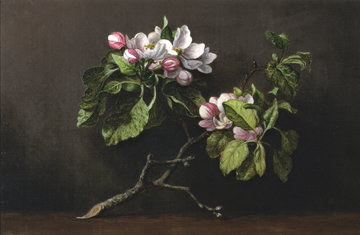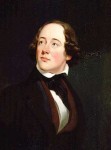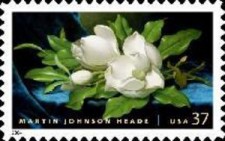
Martin Johnson Heade
American, 1819-1904
Apple Blossom Branch on a Table, 1874
oil on canvas
10 x 15 in.
SBMA, Gift of Charles C. and Elma Ralphs Shoemaker
1994.34.7

Portrait of Martin Johnson Heade as a Young Man, by Thomas Hicks (Heade’s Cousin), early 1840s, collection of the Mercer Museum of the Bucks County Historical Society.
Theodore Stebbins, Jr., now (2012) curator of American art at the Harvard University Art Museums, writes, "...one of the things that has always made the study of Heade's work exciting is the way his paintings continue to turn up in garage sales and other unlikely places all over the country, in a manner that the paintings of Frederic E. Church and John F. Kensett do not." Stebbins speculates the reason for this was Heade's popularity with middle-class buyers, and his willingness to distribute his works widely across the country.
RESEARCH PAPER
This oil painting on canvas is in the permanent collection of the Santa Barbara Museum of Art. The branch is placed in the center of the canvas with the negative and positive space well balanced. It is executed in a precise manner in which the brush strokes cannot be seen. The background is dark to emphasize the luminous quality of the apple blossoms. The branch is highlighted only to add form but not to distract from the composition. The leaves are in the dark but highlights aid the balance of the placement.
The table the branch is set on is plain indicating an earlier period of Heade's work. His later renderings have rich fabrics to cover the table to give a base for the object and a creative vessel to hold the blossoms. Heade painted several apple blossom compositions with little change in the arrangement of the blossoms.
During the Victorian period of Heade's painting career, flowers were used symbolically to indicate the virtues of a lady. Each different species denoted a special virtue. In China the apple blossom was the symbol for female beauty. Heade painted only a few special flowers again and again. He could have been well aware of their symbolic meaning or he may have painted these blossoms simply because he liked them. We may never know.
Heade did not discuss his art or keep a journal, as was the custom of the period. He wrote extensively to his friends discussing the shipping of his paintings and many articles were published that he wrote about hummingbirds, about which he was an expert.
Martin Johnson Heade is one of the most prolific and versatile of the 19th century American painters. He was born August 11, 1819, in Lumberville, Pennsylvania, situated beside the Delaware River. He was the oldest of eight children. His parents, Joseph and Sarah Head were very successful in the business of lumber and other enterprises. Head changed the spelling of his name to Heade in 1846.
When very young, Heade showed an interest in art. He started his art study in 1838-39 with his cousin, Thomas Hicks. This is his period of portrait painting, which was considered "conventional." While still in his teens his father sent him to Rome (1839) for two years to study art. He was to return to Europe two more times, in 1848 and again in 1865. The first professional showing of Heade's art was Portrait of a Little Girl in 1841 at the Pennsylvania Academy in Philadelphia. He continued to exhibit his work regularly for many years. In 1856 landscapes and seascapes began to be seen, but often the place and date were not recorded. He has become most well known for a series of seascapes, The Thunder Storms, which he began in 1869. Heade traveled to Brazil in 1863, 1866 and 1870 where he painted his Hummingbird Series. He married in 1863 at age sixty-five to Elizabeth Smith. They moved to St. Augustine, Florida. This was the beginning of his haystack and marsh scenes. Heade continued painting still-lifes of cut flowers until he died in 1907 in relative obscurity. His art was not taken seriously. He was forgotten until his Thunder Storm series was rediscovered in 1943. Now he is considered a leading American artist.
Heade lived and painted in an active period for the country. The Indians were still being massacred, there was the last of the frontier land, Abraham Lincoln was assassinated and the U.S. declared war on Spain. During this period of unrest, following Andrew Jackson's presidency in 1835, there was a growth of new pride in the American wilderness. The artists of the Hudson River School emerged to paint genre and landscapes. This period was considered the first generation of the Hudson River Artist. Heade's luministic paintings coincided with the second generation of Hudson River artists. He followed, but did not join, any group. It wasn't until 1954 that John I. H. Baur gave the name Luminism to the 1845-1880 period. Some authorities consider Luminism a branch of the Hudson River School, which brought the school to a close. Other authorities considered the Luminists a separate group. Heade was close to a few of the main artists of the second generation of the school, among them Thomas Cole (1801-1848), Frederick Edwin Church (1826-1900), and Albert Bierstadt (1830-1902) whose art was composed of massive landscapes in the green and brown tonality recalling the Dutch and English landscapes. This was intentional as American products were scorned.
Heade was considered one of the Luminists because of his use of brighter colors and the American light, which was considered special. He painted atmosphere and storms, still-lifes of flowers and their arrangement, portraits, and seascapes. Heade and Fritz Hugh Lane were the leading Luminists but Heade was the more versatile although less consistent. Heade's work was also more precise and executed with fine brush strokes. The titles of a few of his works are: Off the Coast of California, South America Scene, High Tide on the Marshes, Apple Blossoms, Fairman Rogers, Approaching Storm, and Beach Near Newport, c. 1867. This last one is the one that is most reproduced in the catalogues and encyclopedias.
Definition of a Still Life: Still Life is a painting of inanimate objects such as books, pipes, and game animals with flowers being on the fringe of the definition but still included as still life. Still Life appeared by 1475 as part of a larger painting. It was in Venice in the early 1500s that the true still life appeared in a painting by Jacopo de Barbari. There were flower still-lifes early in America but it was George Lambdin (1803-1893) and Martin Johnson Heade who were considered the major flower still life specialists in American in the mid-1860s. The public wanted still life paintings and the authorities had to recognize it as a true art form.
The medium, oil paint on canvas: Painting is executed on a flat surface such as plaster, wood, stone, or canvas with a medium such as fresco, tempera, watercolor or oil. The early pigment used was mineral or plant ground and then mixed with a fluid. In the early 1400s the pigment was mixed with linseed oil, which made the medium easier to work. Often the flat surface of the canvas was covered with a ground to make the painting smooth.
Prepared for the Santa Barbara Museum of Art Docent Council by Nancy Robinson, March 1995.
Website preparer: Mary Eckhart

In 2001, the U.S. Postal service began a tradition of honoring American artists with their annual issuance of American Treasures commemorative stamps. The 2004 American Treasures stamp features a painting by Martin Johnson Heade entitled Giant Magnolias on a Blue Velvet Cloth.
SBMA CURATORIAL LABELS
Heade is now recognized as one of the most significant artists of his generation. Though sometimes lumped together with the Hudson River School because of his friendship with Church and the exotic South American landscapes from the 1860s that he made, his art was more diverse, both in terms of subject and style. Church began to treat still-life motifs in the 1870s, and this subject of a blossoming branch from an apple tree exists in numerous variations by his hand. Perhaps, most famous are his still-life compositions that combine hummingbirds and orchids. The poignancy of this sprig of flowers, now severed from its trunk lies, of course, in the traditional "vanitas" theme of the transience of life.
- Preston Morton Reinstallation, 2022
